Zekate house
The Zekate House ( Albanian Shtëpia e Zekatëve ) is a historic Ottoman building in Gjirokastra in southern Albania . The Zekate House, which towers prominently over the city, was built in 1811/12. The home of a wealthy family is a typical example of Ottoman architecture , mixed here with local elements.
Tower-like buildings of this type are called kulla . Their defensive character is more of an ornament. The lower part of the house is made of stone, on which a wooden structure was built. The lower area is divided into two towers - these two wings are connected to each other in the main facade by arches. The house consists of four floors. Below are the former storage rooms and a cistern , above a first reception room, further storage rooms and the kitchen. On the second floor there are two living rooms, which lead off from the reception room on this floor and have a bathroom and toilet. On the upper floor there is the large reception room and two smaller rooms which, in contrast to the heated rooms on the lower floor, were mainly used in summer. The central room where the stairs end has a balcony. The large reception room was mainly used for important celebrations and was probably designed by Petro Korçari.
The builder was Beqir Zeko, who was active in Ali Pasha Tepelena's government. His sons and their families also lived in the house. The magnificent building was intended to express the power and wealth of the family. It is located in the Palorto district on the upper edge of the city and towers over the whole place.
The Zekate house has been called "the most beautiful preserved example of an Ottoman tower house in Gjirokastra" ( Emin Riza ).
When the historic city center of Gjirokastra was placed under protection in 1961, this also included the Zekate building. In 1973 it was designated a cultural monument. For a time an ethnographic museum was housed in it. In 2005 Gjirokastra was declared a UNESCO World Heritage Site. The building was renovated in 2004 and can be visited. The house is uninhabited, but the Zeko family live in an outbuilding at the entrance to the property. The house has been accessible since 2018 during the usual museum opening times - and also on request.
The Zekos were expropriated by Enver Hodscha, the Albanian dictator. After the collapse of the communist system, they got the house back, but were too poor to make the main building habitable. Instead, they have "lovingly" rededicated it into a private museum.
Web links
Individual evidence
- ↑ a b Felicity Booth, Elenita Roshi (ed.): Gjirokastra - the essential guide . Gjirokastra Conservation and Development Organization, Tirana / Norwich 2009, ISBN 978-99956-747-0-0 .
- ↑ a b Zekate House. In: Gjirokastra Conservation and Development Organization. Retrieved November 12, 2014 .
- ↑ a b c Stephan Doempke, Anduela Lulo, Sadi Petrela: Katër qytete historike në Ballkanin jugperëndimor . Ed .: Organizata për Ruajtjen dhe Zhvillimin e Gjirokastrës. Tirana 2012, ISBN 978-99956-747-4-8 , pp. 61 f ( book as PDF [accessed on August 1, 2014]).
- ↑ Lista e Monumenteve - Rrethi i Gjirokastrës. (PDF) In: Instituti i Monumenteve të Kulturës. Retrieved December 5, 2015 (Albanian).
Coordinates: 40 ° 4 ′ 29.5 ″ N , 20 ° 7 ′ 56.3 ″ E

